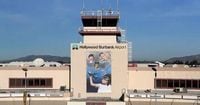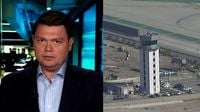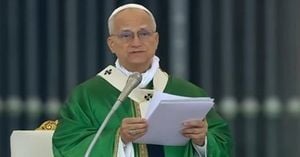Travelers at Hollywood Burbank Airport in California faced an extraordinary situation on October 6, 2025, when the airport's air traffic control tower was left completely unmanned for nearly six hours amid the ongoing U.S. government shutdown. The incident, which began at 4:15 p.m. and lasted until 10:00 p.m., was the most visible sign yet of the shutdown’s impact on air travel, rattling nerves and triggering a cascade of flight delays and cancellations across the region.
According to CNN, the control tower closure stemmed directly from a staffing shortage caused by the shutdown, which forced air traffic controllers to work without pay and led to a surge in workers calling out sick. The Federal Aviation Administration (FAA) had warned that such shortages could disrupt operations at major airports, and on Monday, those warnings became reality for Burbank’s travelers and staff.
During the unmanned period, responsibility for guiding planes in and out of the busy Los Angeles-area airport was shifted to Southern California TRACON, a radar facility based in San Diego that manages airspace for dozens of airports across the region. FAA spokesperson Kristen Alsop told the Los Angeles Times, “Although the air traffic control tower was unmanned, Southern California TRACON controls air traffic in the airport’s airspace.” The facility uses advanced radar technology to coordinate aircraft movements, but the absence of on-site controllers at Burbank was still a jarring development for pilots and passengers alike.
The fallout was immediate. According to airport spokesperson Mike Christensen, a total of 56 flights were delayed and 12 were canceled after 4 p.m. Monday. Outgoing flights saw an average delay of two hours and 31 minutes, with some waiting nearly four hours to depart. The delays were attributed not only to the staffing crisis but also to ongoing runway construction, compounding the chaos. By Tuesday morning, Christensen reported that operations had returned to normal, but the disruption left a lasting impression on travelers and staff.
Across the country, the shutdown’s effects were being felt at other major airports as well. The FAA reported delays at Newark Liberty International Airport, Denver International Airport, and Harry Reid International Airport in Las Vegas on Monday, all linked to similar staffing shortages. Transportation Secretary Sean Duffy, speaking at a news conference at Newark Liberty, sought to reassure the public about safety. “Is our airspace unsafe? No,” Duffy said. “If we think there’s issues in the airspace, we will shut it down... We will delay.” Still, he acknowledged the growing strain on the system, noting a “slight tick-up” in staffers calling out sick and warning that further disruptions could be on the horizon if the shutdown persisted.
The roots of the crisis lie in the political deadlock that triggered the shutdown six days earlier. The U.S. government went into shutdown mode after President Donald Trump’s Republican Party and congressional Democrats failed to agree on a spending bill. Democrats refused to support a measure they argued would make healthcare more expensive for Americans, while Republicans insisted on its passage. The impasse led to the halting of all non-essential federal services and the furlough of hundreds of thousands of workers, while those deemed essential—like air traffic controllers and Transportation Security Administration (TSA) officers—were required to work without pay.
The impact on morale and staffing has been stark. According to a Reuters report cited by Hindustan Times, roughly 13,000 air traffic controllers and 50,000 TSA officers are required to show up for work during the shutdown, despite not receiving paychecks. Many have responded by calling in sick, echoing scenes from the 35-day shutdown in 2019, when widespread absences among controllers and TSA staff led to major disruptions at airports nationwide. Transportation Secretary Duffy told reporters that air traffic staffing had been cut by 50% in some areas since the shutdown began, a figure that underscores the scale of the challenge.
California Governor Gavin Newsom was quick to place blame for the crisis. In a pointed statement on X (formerly Twitter), Newsom wrote, “Thanks, @realDonaldTrump! Burbank Airport has ZERO air traffic controllers from 4:15pm to 10pm today because of YOUR government shutdown.” The political finger-pointing highlighted the deep divisions in Washington and the real-world consequences for ordinary Americans caught in the crossfire.
Industry voices echoed Newsom’s concerns. The National Air Traffic Controllers Association (NATCA), the union representing controllers, described the Burbank incident as “the latest example of how fragile our aviation system is in the midst of a national shortage of these critical safety professionals.” In a statement to Los Angeles Times, the union warned, “NATCA has consistently warned that the controller staffing shortage leaves the system vulnerable, and today’s events underscore the urgent need to accelerate training and hiring.” The union noted that nearly 11,000 controllers were working without pay during the shutdown, many logging ten-hour shifts up to six days a week to keep the system running.
The long hours and lack of pay are taking a toll on workers. NATCA has called for the FAA to ramp up hiring and training efforts, pointing to the current crisis as proof of the system’s fragility. The union said it was collaborating with the FAA to minimize disruptions for travelers and would continue to advocate for policies that strengthen the workforce. “Today’s events underscore the urgent need to accelerate training and hiring,” the union reiterated.
The Burbank incident is not the first time a government shutdown has threatened airport operations. In January 2019, the FAA temporarily halted flights into LaGuardia Airport in New York City after a wave of controller absences, a move that lasted just 82 minutes but helped force a resolution in Washington. Monday’s events in Burbank reignited fears of a similar scenario, as delays and cancellations rippled through the system and pressure mounted on lawmakers to find a solution.
For now, flights have resumed at Hollywood Burbank Airport, and officials insist that safety was never compromised, thanks to the backup provided by Southern California TRACON. But the episode has served as a stark reminder of how quickly political gridlock can spill over into daily life, disrupting travel plans and highlighting the essential, often underappreciated, work of those who keep the nation’s skies safe.
As the shutdown drags on, travelers and aviation workers alike are left wondering when relief will come—and whether the system can withstand another prolonged standoff in Washington.





